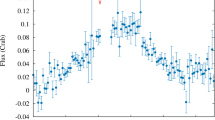Abstract
The Be X-ray pulsar SMC X-3 underwent an extra long and ultraluminous giant outburst from 2016 August to 2017 March. The peak X-ray luminosity is up to \(\sim10^{39}~\mbox{erg/s}\), suggesting a mildly super-Eddington accretion onto the strongly magnetized neutron star. It therefore bridges the gap between the Galactic Be/X-ray binaries (\(L_{\mathrm{X}}^{\mathrm{peak}} \leq10^{38}~\mbox{erg/s}\)) and the ultraluminous X-ray pulsars (\(L_{\mathrm{X}}^{\mathrm{peak}} \geq10^{40}~\mbox{erg/s}\)) found in nearby galaxies. A number of observations were carried out to observe the outburst. In this paper, we perform a comprehensive phase-resolved analysis on the high quality data obtained with the Nustar and XMM-Newton, which were observed at a high and intermediate luminosity levels. In order to get a better understanding on the evolution of the whole extreme burst, we take the Swift results at the low luminosity state into account as well. At the early stage of outburst, the source shows a double-peak pulse profile, the second main peak approaches the first one and merges into the single peak at the low luminosity. The second main peak vanishes beyond 20 keV, and its radiation becomes much softer than that of the first main peak. The line widths of fluorescent iron line vary dramatically with phases, indicating a complicated geometry of accretion flows. In contrast to the case at low luminosity, the pulse fraction increases with the photon energy. The significant small pulse fraction detected below 1 keV can be interpreted as the existence of an additional thermal component located at far away from the central neutron star.


Similar content being viewed by others
Notes
See XMM-Newton Users Handbook, http://xmm-tools.cosmos.esa.int/external/xmm_user_support/documentation/uhb/.
References
Arnaud, K.A.: In: Jacoby, G.H., Barnes, J. (eds.) Astronomical Data Analysis Software and Systems V. ASP Conf. Ser., vol. 101, p. 17. ASP, San Francisco (1996)
Basko, M.M., Sunyaev, R.A.: Mon. Not. R. Astron. Soc. 175, 395 (1976)
Becker, P.A., Klochkov, D., Schönherr, G., et al.: Astron. Astrophys. 544, A123 (2012)
Bildsten, L., Chakrabarty, D., Chiu, J., et al.: Astrophys. J. Suppl. Ser. 113, 367 (1997)
Buccheri, R., Bennett, K., Bignami, G.F., et al.: Astron. Astrophys. 128, 245 (1983)
Casares, J., Negueruela, I., Ribo, M., et al.: Nature 505, 378 (2014)
Clark, G., Doxsey, R., Li, F., Jernigan, J.G., van Paradijs, J.: Astrophys. J. 221, L37 (1978)
Edge, W.R.T., Coe, M.J., Corbet, R.H.D., Markwardt, C.B., Laycock, S.: Astron. Telegram 225, 1 (2004)
Galache, J.L., Corbet, R.H.D., Coe, M.J., et al.: Astrophys. J. Suppl. Ser. 177, 189 (2008)
Gao, Z.-F., Li, X.-D., Wang, N., et al.: Mon. Not. R. Astron. Soc. 456, 55 (2016)
Gao, Z.-F., Wang, N., Shan, H., et al.: Astrophys. J. 849, 19 (2017)
Ghosh, P., Lamb, F.K.: Astrophys. J. 234, 296 (1979)
Graczyk, D., Pietrzyński, G., Thompson, I.B., et al.: Astrophys. J. 780, 59 (2014)
Haberl, F.: Astron. Astrophys. 296, 685 (1995)
Haberl, F., Eger, P., Pietsch, W.: Astron. Astrophys. 489, 327 (2008)
Haberl, F., Sturm, R.: Astron. Astrophys. 586, A81 (2016)
Harrison, F.A., Craig, W.W., Christensen, F.E., et al.: Astrophys. J. 770, 103 (2013)
Hickox, R.C., Narayan, R., Kallman, T.R.: Astrophys. J. 614, 881 (2004)
Hilditch, R.W., Howarth, I.D., Harries, T.J.: Mon. Not. R. Astron. Soc. 357, 304 (2005)
Lamb, F.K., Pethick, C.J., Pines, D.: Astrophys. J. 184, 271 (1973)
Leahy, D.A.: Astron. Astrophys. 180, 275 (1987)
Li, J., Wang, W., Zhao, Y.H.: Mon. Not. R. Astron. Soc. 423, 2854 (2011)
Lyne, A.G., Graham-Smith, F.: Pulsar Astronomy, 4th edn. Cambridge University Press, Cambridge (2012)
Manchester, R.N., Taylor, J.H. (eds.): Pulsars. Freeman, San Francisco (1977)
Mushtukov, A.A., Suleimanov, V.F., Tsygankov, S.S., Poutanen, J.: Mon. Not. R. Astron. Soc. 447, 1847 (2015)
Postnov, K., Oskinova, L., Torrejón, J.M.: Mon. Not. R. Astron. Soc. 465, L119 (2017)
Reig, P.: Astrophys. Space Sci. 332, 1 (2011)
Sartore, N., Jourdain, E., Roques, J.-P.: Astrophys. J. 806, 193 (2015)
Scowcroft, V., Freedman, W.L., Madore, B.F., et al.: Astrophys. J. 816, 49 (2016)
Takagi, T., Mihara, T., Sugizaki, M., Makishima, K., Morii, M.: Publ. Astron. Soc. Jpn. 68, S13 (2016)
Townsend, L.J., Kennea, J.A., Coe, M.J., et al.: Mon. Not. R. Astron. Soc. 471, 3878 (2017)
Tsygankov, S.S., Doroshenko, V., Lutovinov, A.A., Mushtukov, A.A., Poutanen, J.: Astron. Astrophys. 605, A39 (2017)
Wang, Y.-M.: Astron. Astrophys. 102, 36 (1981)
Weng, S.-S., Ge, M.-Y., Zhao, H.-H., Wang, W., Zhang, S.-N., Bian, W.-H., Yuan, Q.-R.: Astrophys. J. 843, 69 (2017). Paper I
Weng, S.-S., Ge, M.-Y., Zhao, H.-H., Wang, W., Zhang, S.-N.: Astron. Telegram 9731, 1 (2016)
Acknowledgements
This research has made use of public data obtained from the High Energy Astrophysics Science Archive Research Center, provided by NASA’s Goddard Space Flight Center. We thank the anonymous referee for the helpful comments. We thank Jun-Xian Wang and Sergey Tsygankov for many valuable discussions. This work is supported by the National Natural Science Foundation of China under grants 11703014, 11673013, 11503027, 11373024, 11233003, 11433005, 11573023 and 11233001, National Program on Key Research and Development Project (Grant Nos. 2016YFA0400803 and 2017YFA0402703). H.H.Z. acknowledges support from the Natural Science Foundation from Jiangsu Province of China (Grant No. BK20171028), and the University Science Research Project of Jiangsu Province (17KJB160002). Q.R.Y. thanks support from the Special Research Fund for the Doctoral Program of Higher Education (grant No. 20133207110006).
Author information
Authors and Affiliations
Corresponding author
Rights and permissions
About this article
Cite this article
Zhao, HH., Weng, SS., Ge, MY. et al. Pulse phase-resolved analysis of SMC X-3 during its 2016–2017 super-Eddington outburst. Astrophys Space Sci 363, 21 (2018). https://doi.org/10.1007/s10509-017-3245-2
Received:
Accepted:
Published:
DOI: https://doi.org/10.1007/s10509-017-3245-2




